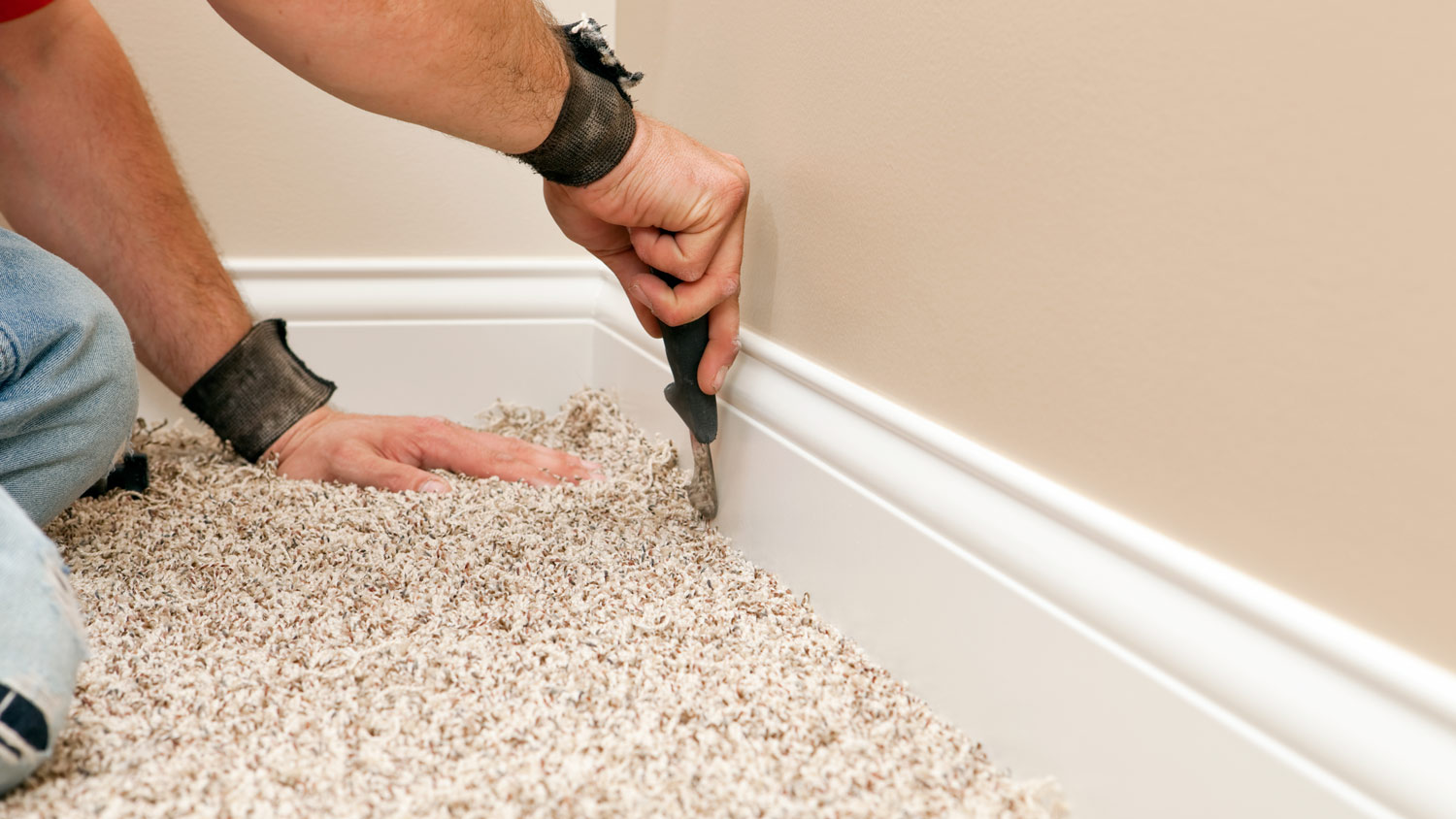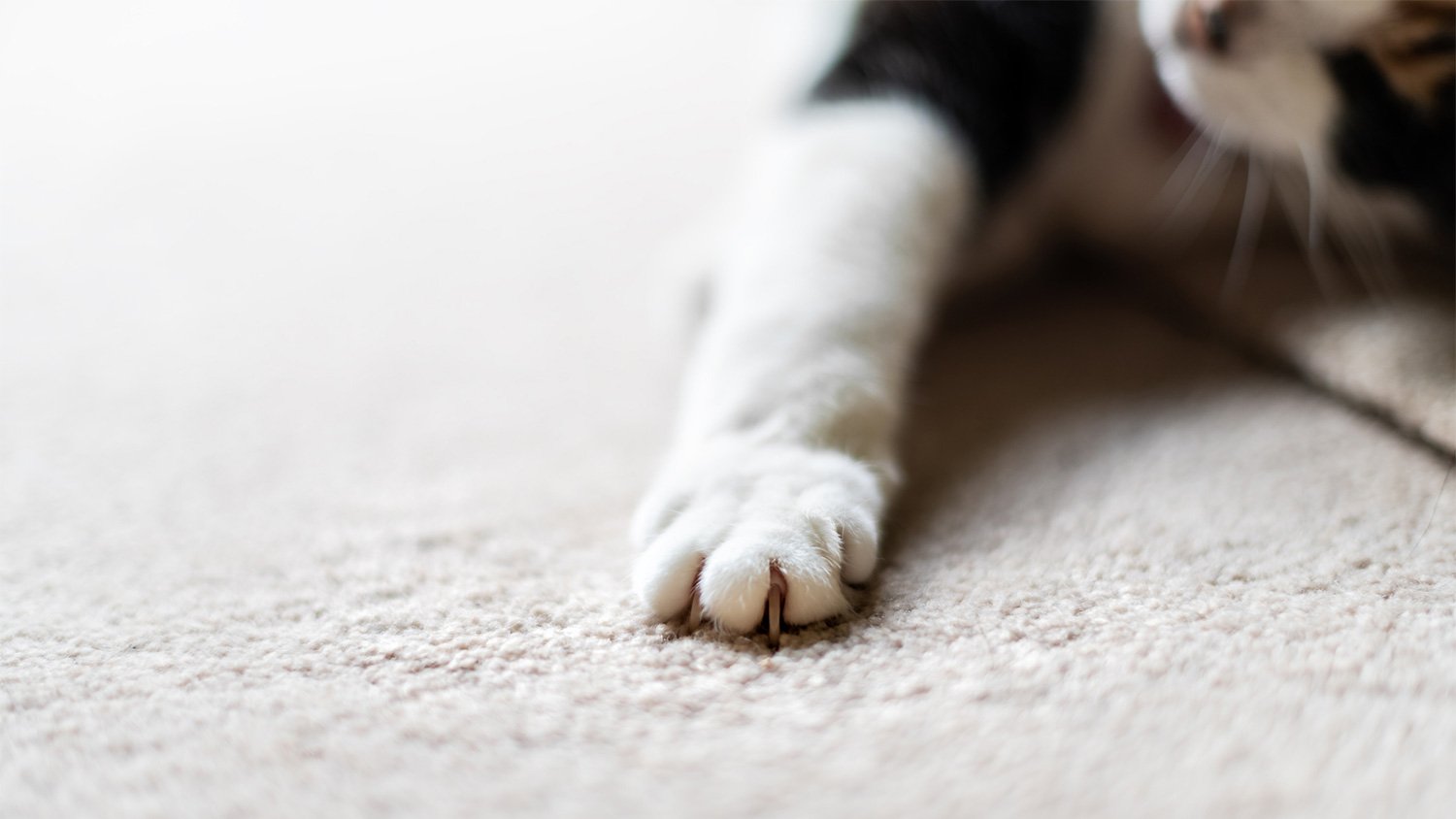
Get a clear estimate for carpet repair cost. Learn what impacts pricing, compare repair types, and find ways to save on your next carpet project.
Here, we close the loop on damage to Berber carpets


Berber carpet loops are easily snagged by vacuums, pet claws, or when furniture is moved.
Professional carpet repair costs about $250 on average, but repairing a Berber carpet is significantly less expensive than replacing it.
A local carpet repair pro will have the expertise and supplies to repair stains, burns, missing patches, and other types of damage.
Particularly popular in the ‘90s, Berber carpet was once only used in high-traffic areas, like basements and living rooms. Lately, though, it has been making a comeback and is now being installed in many areas of the home. This resurgence is largely thanks to new colors—it is not only available in the traditional speckled style, but comes in solid hues as well, making it versatile and able to fit in with every kind of home decor.
Many homeowners love its low cost and easy cleanup potential, as its looped design repels spills better than other carpets. That same design, however, can create snags that quickly go from minor to major, especially if you have small kids or pets running around. Learn the ins and outs of Berber carpet repair in this guide to taking care of common repair problems in no time.
There are lots of great things about Berber, but one disadvantage is that the carpet loops are easily snapped. Loop damage can happen for a variety of reasons, like dragging carpet across the floor, pets clawing at the carpet, or even a loose strand getting pulled by a vacuum cleaner.
When faced with serious carpet damage, you will likely consider carpet removal costs and everything else associated with reinstallation. However, in many cases, you do not have to go that far. For the most part, you can repair common issues like loop damage, burn marks, missing patches, stains, and the like without needing to consider replacement.
Carpet repair costs $150 to $250 for snags, stains, and burn damage. Pet damage can cost $150 to $1,000, depending on how bad it is.
Here are five common ways your Berber can be damaged, and what you can do about it.
All types of Berber carpet are susceptible to loop damage. Single-loop (otherwise known as single-strand) damage occurs when a strand of carpet gets pulled up. It tends to look like when you have cut the grass and left one long weed sticking out in the middle.
Damage to a single strand (or even two to three strands) is a simple fix. To get your Berber looking new again, you should gather:
A hot glue gun
A flathead screwdriver
Small scissors
Using either your fingers or a screwdriver, see if you can simply push the strands back down. Often enough this works and you do not have to do anything else.
If the strands refuse to stay down just with pressure, you will want to bust out the hot glue gun. Take the strand, push it down, and glue it in place using the tiniest bit of glue. This will prevent the carpet from snagging again—and may even hold up better than the rest of the carpet in the long run.
Alternatively, if the damaged loop is in a not-so-noticeable area, you can get away with just cutting the loops. It will not cause the carpet to unravel more, and you do not have to worry about it being seen.

Multi-loop damage can happen from vacuuming, scampering pets and children, or by moving furniture. In this case, you typically have multiple loops coming up, and the carpet suddenly looks like a bunch of yarn was dropped on the floor.
You will need to patch up the affected carpet so it does not keep unraveling. Patching carpet really only works, though, if the damaged area is one square foot or less in size; otherwise, the fix might be too obvious to the naked eye. If there is lots of damage or multiple areas of damage in one room, consider recarpeting entirely.
To do this, you should collect the following:
A utility knife
An awl or capped pen
A spare piece of carpet—ideally, you have a few scraps left over from the initial installation, or you can ask the manufacturer for some if the style is still in production. If neither of those options is possible, cut a square from an inconspicuous place, like underneath a TV stand or the floor of a closet.
Double-sided carpet tape
After you have your tools ready, you can begin.
Mark the area you will cut with the awl or the cap side of the pen. Drag the tool into a square shape, separating the carpet fibers, so you only cut out what you need.
Cut out the square area with a utility knife; try only to cut into the carpet backing, not into the Berber loops.
Trace the shape of the cut-out piece on the area where you will gather the spare carpet using the awl or the pen.
Cut the replacement patch using the utility knife, once again trying only to cut into the backing, not the fibers.
Cut two strips of double-sided carpet tape to cover two edges of the patch’s backing.
Remove one side of protective paper from the tape strips and apply them to the floor where the patch will go.
Remove the other side of the protective paper, and put the patch into place.
If your Berber carpet has patterns and designs, this DIY fix might not look too great. You may want to call a carpet repair company near you so they can seamlessly install a new piece.
Burn damage can happen and, as long as the damage is only done to the fibers and not to the carpet pad underneath, you can DIY a quick fix.
Prepare the following:
Scissors
A bit of matching carpet—you will not be cutting out a patch, but you will need to “borrow” some fibers from the area
A glue gun
To repair the burned carpet, remove the burnt fibers by cutting them out with your pair of scissors. From there, locate your out-of-the-way spot of carpet (like behind a door or inside of a closet) that you are willing to sacrifice.
Next, cut some undamaged fibers with your scissors until you have enough to cover the burn patch. Finally, glue the untouched fibers over the damaged spot with a glue gun.
If the burn damage did get into the carpet pad, it is better to replace the area as you would for multi-loop damage or replace the entire carpet.
You might have missing patches due to a variety of reasons; for instance, some pets like to chew on or scratch at carpeting, and some vacuum cleaners snag on the strands, creating many spots of missing loops over time.
If there are only a couple of small missing patches of carpet (measuring less than one square foot), you can follow the same procedure as described above for areas with burn damage. If there are large sections that cannot be covered with the amount of spare carpet you have around, it is time to call in a professional to replace the entire Berber.

Tackling stains depends on what material your Berber carpet is made from. To tackle wool Berber, steam clean the carpet. This will help to remove the dirt and grime found deep in the carpet fibers.
For simple stains on nylon, consider using a mixture of baking soda and vinegar to clean and revive your carpet pile. Do not scrub too hard, though, as this could cause the loops to unravel.
While the most common issues with Berber carpet can be repaired, sometimes you have to go with a full replacement. Problems that can be repaired include snags, runs, stains, bare patches, holes, and burn damage.
A full replacement is certainly needed when your carpet has extensive water damage. You may notice visible mold or mildew, or notice a strong smell. Your carpet may have discoloration, or there may be ripples in the flooring. Often, water damage is not isolated to just your carpet, and you may need to replace your underlayment and even repair your subfloor.
Additionally, you should look at how old your Berber carpet is. The average lifespan is 10 to 15 years, so if it has been longer than that, it may be a good time to replace the carpet, regardless of whether there are issues that need repair or not. In these cases, you should hire a carpet removal company and installer near you.
DIYing your Berber carpet repair will likely cost $25 or less. So, as long as you have the time and patience to get it done, this is the most affordable option. Otherwise, you can hire a carpet repair company to help get your flooring back to looking its best. For professional help, you can expect to pay $150 to $250 for common issues including snags, stains, and burn spots.
I had Ace Fireplace Services install custom chimney caps for my home, and the results are stunning. They fit like a glove and have added a touch of sophistication to my chimney. I can't recommend their services enough.
I first met Ilia when windows were installed on my new back porch. He was extremely conscientious about getting the job done right and it was. Now I ve had all the windows of two levels of my house completed by him.....ON TIME, ON BUDGET, TO MY TOTAL SATISFACTION. I'm a happy customer.
AFS was excellent from start to finish. Jess, the sales associate, was fantastic...very knowledgeable and very professional. The installation crew was excellent. I couldn't be more pleased with the process. Best of all, my new floor looks fantastic!
Great experience all together. Dog friendly, courteous, great results and honest with recommendations. Will certainly be using Cardinal in the future for any carpet repairs
Bill Gerhardt sold the company to his employees at the end of 2019, apparently without a workable succession plan and without notifying prospective customers of this fact. Most aspects of the maintenance contract have not been fulfilled: no installation of anual plantings per contract, no...
Logan did a superior job: on time, efficient, pleasant and helpful salesman, craftsmen installers. All went well, and I'd surely hire them again.
Kathy was great to work with. Always responsive and punctual. She was able to accomodate my work schedule with evening and even weekend appointments, a huge plus for me. Install was quick. One of the blinds was defective and she was quick about ordering the replacement and reinstalling. Her...
his summer it was time... after building my home in 2010 I didn't think I would need to replace my windows for a while, but about 3/4 years after we moved in, our windows started fogging up. Our energy bills weren't too bad, however we knew our current windows were not efficient. So the...
It went fantastic! Paul arrived at pre-arranged time to look at the basement, discuss options and quote price. A few days later I called him to get things rolling. He arrived on time and I gave him the designated down payment. The crew arrived at 8AM on the scheduled day and immediately began...
I was delighted with SemBro. The kitchen designer (Nadia) created a design that was both very attractive and functional, including some features that we had not ourselves imagined (e.g., corner cabinets). The design far exceeded what another company had generated. After we visited the...
From average costs to expert advice, get all the answers you need to get your job done.

Get a clear estimate for carpet repair cost. Learn what impacts pricing, compare repair types, and find ways to save on your next carpet project.

Carpet padding makes your carpet feel extra comfortable and protects your floors from damage, but how much does carpet padding cost? Let’s look at the numbers.

The cost to carpet stairs depends on the number of stairs, material choice, and staircase type. Read on to calculate your project expenses

Between wool versus nylon carpet, which should you choose? Your carpet will be under your feet for years to come, so picking the right material is crucial.

Rugs and carpets play different but important roles as flooring options in your home. Here’s what to think about when comparing these two popular options.

Do you have a hole or burn mark in your carpet that you can't deal with any longer? Read this guide to learn how to patch carpet and fix it yourself.